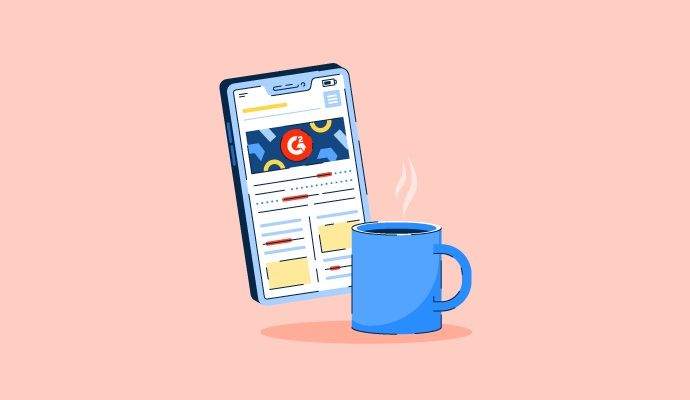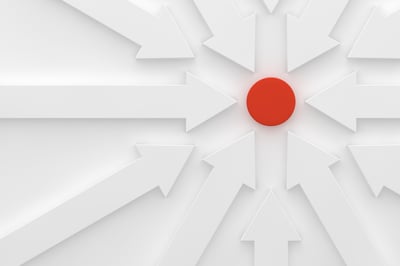January 14, 2021
 by Forum Sheth / January 14, 2021
by Forum Sheth / January 14, 2021

If you represent a B2C business, you’d know how challenging it is to acquire new customers.
As the cost of acquisition (CAC) continues to increase too. However, it’s still tempting to keep acquiring new customers to grow your business and market share.
But what if you could drive similar revenue, in fact, a higher ROI by spending less than what you spend on acquisition? You can do it by retaining your existing customers.
Have you heard of the most common rule used by a majority of successful companies across the world? These companies have been following the proven 80/20 rule where 20% of customers contribute to about 80% of business.
Moreover, research proves that returning customers have a 60-70% chance of purchasing a service or product again.
The process of engaging existing customers and encouraging them to keep coming back to your brand properties to shop again or continue using your services, is, in simple terms, customer retention.
While customer acquisition focuses on attracting new customers (leads), customer retention promotes the idea of generating revenue from your existing customers.
When you focus on increasing your retention rate, you also increase the lifetime value (CLV) of your customers. High CLV means your customers bring in more revenue for your business and you have to spend less on acquiring new customers. Moreover, the LTV to CAC ratio is an indicator of your business health. Three to one is generally considered to be a good ratio and indicates that your business is generating enough revenue to sustain and remain profitable.
However, every business has its way of measuring user retention, like retention rate or returning customer rate or repeat sale, because not all products and services demand similar retention metrics. So it’s vital to develop retention strategies based on your business stage, type, and the product or service you offer.
The answer to this is that it depends on which stage of the brand lifecycle you’re in. The number of resources you spend behind retaining customers may vary from stage-to-stage, but there is no denying to the fact that customer retention helps in moving your business from one stage to another.
There are essentially five stages of the brand lifecycle:
Your business has just started, you do not have a steady stream of customers. You are still trying to figure out your market proposition. In the infancy stage, your focus should be on customer acquisition and making sure you provide the best possible service to your first-time customers. Your customer profile is usually early adopters who are willing to take the risk and are rarely loyal to a product, category, or brand. Your strategy should be 90% acquisition and 10% retention.
Your business is gaining traction and you are now optimizing your business model. You learn, re-learn and unlearn from your mistakes and focus on streamlining your operations.
In the rapid growth stage, your focus should be on providing excellent customer support. Here every customer counts. You need to continue focusing on customer acquisition but start increasing your retention efforts as well. Your strategy should be 75% acquisition and 25% retention.
Your business is consistent in its performance. You have a steady stream of customers and your business is now profitable. At this stage, your focus is on optimizing your brand value to prepare for the next phase of growth.
Here, you need to focus on positive word-of-mouth and make sure people now resonate with your brand. You need to increase your profit margins to scale up your operations and spend aggressively on acquiring new customers. Your strategy should be 65% acquisition and 35% retention.
In this stage, you have an established brand image and your customers are well aware of your offerings. They do consider your brand before making an informed purchase decision and the average lifetime value of your customers has reached its peak. In this stage, your mix of both acquisition and retention should be equal. Your strategy should be 50% acquisition and 50% retention.
Your business is now matured. You are well utilizing your business and adjacent product categories to your benefit. Some businesses in this stage may also be publicly listed. Stakeholder profitability is the highest priority for business owners at this junction.
Cost reduction plays a major role in most business decisions and a massive focus is placed on customer retention as opposed to customer acquisition. You provide exceptional customer experience and are aggressively looking out for ways to optimize it even further. Your strategy should be 40% acquisition and 60% retention.
In order to see customer retention in action, you need a powerful strategy. The most successful customer retention strategies empower you to build a strong set of potential repeat buyers who eventually become your loyal customers and brand advocates. Eventually, your brand advocates develop word-of-mouth which aids your acquisition efforts. So it’s wise to say retention also brings in opportunities of acquiring new customers.
Let’s think of an online lingerie brand. A potential buyer visits the website (lead) for the first time and happily places an order (converting into a customer). But what next? The lingerie brand engages with the same customer and encourages her to come back every few months to continue shopping from their website. That is a classic example of implementing an effective customer retention strategy.

Keep up with what’s really going down in marketing with the G2 Tea newsletter. Subscribe here
Before you implement a customer retention strategy, you need to get the following things in place.
Analyze your existing marketing strategies, the ongoing and past campaigns, and draw conclusions based on the performance.
Make sure you incorporate your customer’s feedback into your product/service, before starting off. A good way to ensure this would be to dig into the customer’s historic data, previously run surveys, and so on.
Dig deep into your customer data and behavior on your platform (website/app) Is it the newly acquired users who are willing to transact for the first time? Or the loyal customers who purchase again and again? Analyze factors like product inclinations, transaction history, purchase frequency and behavior to drive repeat purchases from your existing customers.
Sweeping off the roadblocks is a crucial step to ascertain the success of your customer retention initiatives. Trivial yet significant aspects like your web page loading at a slow speed, negative customer reviews, lack of the right technology to implement your campaigns, and so on – these must be fixed well before jumping into planning and executing customer retention strategies.
Do you also provide products in complementary categories to what your customers have already purchased? Is there a potential for your business to upgrade your customers? Is there a possibility your customer may also require an additional product to amplify their product usage experience. Make a list of all such upsell and cross sell opportunities.
Now let’s explore some proven customer retention strategies that would help you increase your conversion rate through existing customers.
Visitors love upgrading their knowledge. Whether it’s about a product or a service they recently purchased from your platform or something that generally benefits them. It’s best to engage with your leads and convince them to convert.
Ideas for campaigns that can be planned for converting leads into customers:
Once a user becomes a customer, your job doesn’t end there. In fact, you’d want to make the customer feel valued and appreciated.
Here are some Ideas for post-purchase campaigns:
Competition is inevitable. It’s always around and it only gets tougher by the day. So how do you strike a chord with your customers in a highly competitive space?
Tell your customers what they want to hear or see. Stitch it well and subtly with your brand and help your customers explore how you’re different from the competition. One of the most important aspects of retention is to offer your core product/service value as soon as possible.
Answer questions like:
If you have an app, send a push notification informing the user about your support availability or send a push notification on your website. You can also send some product recommendations based on their actions on your platform or their purchase history.
The most important cohort to up your retention game is those customers who keep coming back to your platform and buy your product or service several times without exploring multiple options on the internet. These are your brand advocates who you might want to be in constant contact with and make them feel valued.
Here are some ideas you can implement for your loyal customers:
One of the proven ways to stay in touch with the customer and keep them coming back to your platform is to seek feedback about their purchase experience, the overall experience on the platform, and more. This allows you to identify what your customers love the most about your brand and the areas where you need to bring improvements that the customers would like to experience.
The best way to collect feedback is to run customized surveys for users at every stage of the funnel. You could run net promoter score (NPS) surveys, product rating notifications, and so on.
But the key point to note here is how do you ensure you send out the NPS survey to the right set of customers? It’s logical that you’d want to run NPS surveys once a user has experienced your product/service. You can segment your users based on:
The classification will help you target the right set of customers to solicit NPS barring the ones who haven't even experienced your product/service yet.
Dig into your user data and analyze your inactive customers' past purchase history. Identify the trends and act on the reasons why customers got sleepy and never came back to your platform. Re-engaging with your dormant customers opens up their chances of purchasing again from your platform as they were once your customer.
Here are some ideas for reactivation campaigns:
Much like the loyal customers, you’ll always experience a bunch of customers who keep coming back to your platform. But these customers might also explore other options available in the market.
However, you always need to pay attention to the buyers who purchase your product or service for the first time and return to your platform for more – encouraging them to become your loyal customer. Who doesn’t love a first-time buyer coming again to purchase from your platform?
Try these campaigns to encourage repeat purchases:
Building a social media community is like adopting a two-pronged approach – it helps in keeping the customers engaged with your brand and also acts as word-of-mouth when customers talk about your brand on social media.
Here are a few ideas to expand your social media community:
You have a great product, an amazing website and app, but you aren’t available when your customers need help. This disappoints a potential customer and gives them a reason to look out for other options.
Here’s how you can be there for your customers when they need assistance:
Funnels are a great way to identify at what stage are your customers dropping off. Make use of funnel analysis to answer questions like:
Marketing automation platforms help you create funnels, analyze them and make informed decisions on sending the next campaign based on the customer’s behavioral data.
As much as customers do not like being bombarded with messages, you wouldn’t want to engage with your customers via channels they aren’t even available on. It is wise to send your campaigns on your customer’s preferred channel of communication and at the right time – when the user is most likely to interact.
Marketing automation platforms provide you the option of send-time optimization. Based on your users’ past interactions and behavior, they provide you insights on what day and time of the week are the most optimal to send the communication. Sending communication on your users’ preferred time can boost your engagement rates significantly.
The best marketing automation platforms also provide a channel reachability overview which helps you identify the channels that the user is most active on. And reach out to the user on those particular channels.
Monitoring engagement and retention metrics help you identify the value and revenue that the existing customers bring to your business. Metrics like churn rate, retention rate, active users, and more can help you analyze the impact of your customer retention strategy and mould it accordingly.
If you don’t know where to start, take the help of engagement metric guides to choose the most important metrics that you need to track for your business. While you implement the customer retention strategies, do remember to keep an eye on certain pitfalls that you would definitely want to stay away from.
Finally, the last but an important thing (more than a strategy) to remember is to ensure that every retention initiative is based on the fact that the receiver is always going to be an individual who’ll be consuming your content. So make sure your engagement and retention campaigns are individualized and tailored with the human element.
Try to understand what your customer likes and dislikes just as a friend or a family member would. And deliver experiences that reflect emotions and care at every stage of the user lifecycle. After all, when you make your customers feel valued and just as if they’re as important as friends, your customers will not only adore your brand but also become loyal towards your brand.
As you get set for implementing some of the proven strategies of user retention, remember to make sure you avoid some of the most common mistakes that marketers end up making. Here are some of the mistakes that are usually overlooked:
Avoiding these mistakes will help you stay on top of your retention game and drive business growth. A marketing automation platform can help you avoid most of the mistakes and aid you in improving your retention metrics. Let’s understand how marketing automation helps you improve your customer retention!
Marketing automation facilitates a cohesive view of every user and aids businesses in carrying out targeted and hyper-personalized omni-channel user engagement based on the user’s actions and preferences at a scale of millions.
When you have all your user data in one place, you can build lifecycle campaigns based on the user segments you define. You can identify about to churn, loyal, at risk and more such customer segments using recency, frequency, monetary value (RFM) segmentation.
Such user transitions are crucial for a retention marketer to capture to plan effective retention marketing campaigns.
Brands across the globe have already started leveraging marketing automation to fuel their user engagement and retention initiatives. The benefits of using a marketing automation platform are endless.
Forum has been writing SaaS content for over half a decade now. In her current role as the Head of Content Marketing at WebEngage, she has successfully built and trained a team of content marketers who strive to create content that strikes a chord with product and marketing professionals in a massively crowded marketing automation space.
Facebook retargeting isn't exactly new to the paid social advertising world.
 by Sean Thomas Martin
by Sean Thomas Martin
Today’s buying process is more about creating relationships than transactions, and like any...
 by Cristina Maria
by Cristina Maria
Long-lasting customer relationships are vital to growing any business.
 by Nupura Ughade
by Nupura Ughade
Facebook retargeting isn't exactly new to the paid social advertising world.
 by Sean Thomas Martin
by Sean Thomas Martin
Today’s buying process is more about creating relationships than transactions, and like any...
 by Cristina Maria
by Cristina Maria


